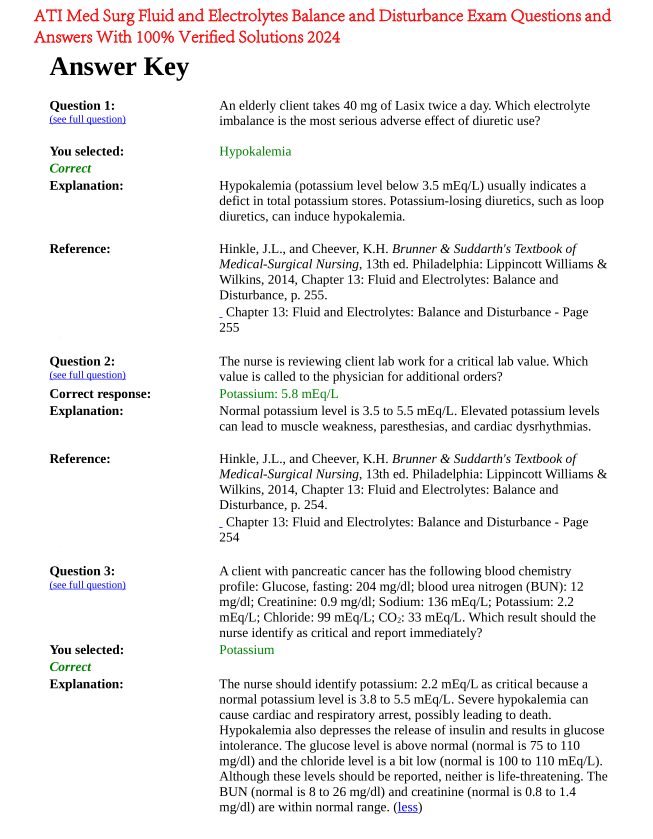Answer Key
Question 1:
(see full question)
An elderly client takes 40 mg of Lasix twice a day. Which electrolyte
imbalance is the most serious adverse effect of diuretic use?
You selected: Hypokalemia
Correct
Explanation: Hypokalemia (potassium level below 3.5 mEq/L) usually indicates a
defict in total potassium stores. Potassium-losing diuretics, such as loop
diuretics, can induce hypokalemia.
Reference: Hinkle, J.L., and Cheever, K.H. Brunner & Suddarth’s Textbook of
Medical-Surgical Nursing, 13th ed. Philadelphia: Lippincott Williams &
Wilkins, 2014, Chapter 13: Fluid and Electrolytes: Balance and
Disturbance, p. 255.
Chapter 13: Fluid and Electrolytes: Balance and Disturbance – Page
255
Question 2:
(see full question)
The nurse is reviewing client lab work for a critical lab value. Which
value is called to the physician for additional orders?
Correct response: Potassium: 5.8 mEq/L
Explanation: Normal potassium level is 3.5 to 5.5 mEq/L. Elevated potassium levels
can lead to muscle weakness, paresthesias, and cardiac dysrhythmias.
Reference: Hinkle, J.L., and Cheever, K.H. Brunner & Suddarth’s Textbook of
Medical-Surgical Nursing, 13th ed. Philadelphia: Lippincott Williams &
Wilkins, 2014, Chapter 13: Fluid and Electrolytes: Balance and
Disturbance, p. 254.
Chapter 13: Fluid and Electrolytes: Balance and Disturbance – Page
254
Question 3:
(see full question)
A client with pancreatic cancer has the following blood chemistry
profile: Glucose, fasting: 204 mg/dl; blood urea nitrogen (BUN): 12
mg/dl; Creatinine: 0.9 mg/dl; Sodium: 136 mEq/L; Potassium: 2.2
mEq/L; Chloride: 99 mEq/L; CO 2 : 33 mEq/L. Which result should the
nurse identify as critical and report immediately?
You selected: Potassium
Correct
Explanation: The nurse should identify potassium: 2.2 mEq/L as critical because a
normal potassium level is 3.8 to 5.5 mEq/L. Severe hypokalemia can
cause cardiac and respiratory arrest, possibly leading to death.
Hypokalemia also depresses the release of insulin and results in glucose
intolerance. The glucose level is above normal (normal is 75 to 110
mg/dl) and the chloride level is a bit low (normal is 100 to 110 mEq/L).
Although these levels should be reported, neither is life-threatening. The
BUN (normal is 8 to 26 mg/dl) and creatinine (normal is 0.8 to 1.4
mg/dl) are within normal range. (less)
